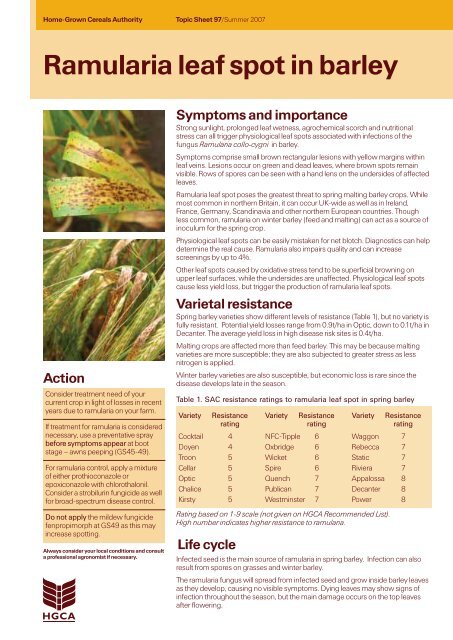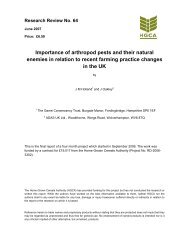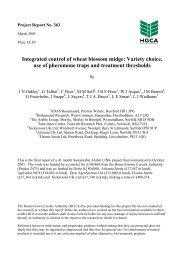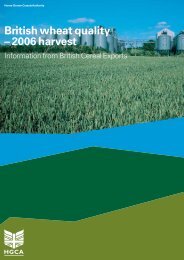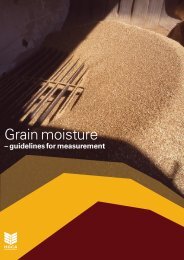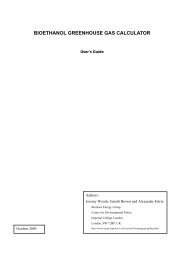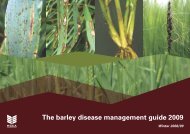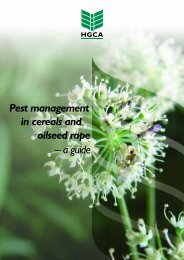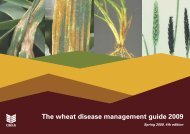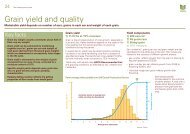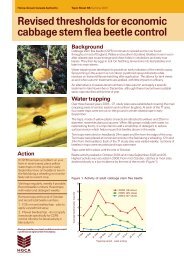Ramularia leaf spot in barley - HGCA
Ramularia leaf spot in barley - HGCA
Ramularia leaf spot in barley - HGCA
Create successful ePaper yourself
Turn your PDF publications into a flip-book with our unique Google optimized e-Paper software.
Home-Grown Cereals Authority Topic Sheet 97/Summer 2007<strong>Ramularia</strong> <strong>leaf</strong> <strong>spot</strong> <strong>in</strong> <strong>barley</strong>ActionConsider treatment need of yourcurrent crop <strong>in</strong> light of losses <strong>in</strong> recentyears due to ramularia on your farm.If treatment for ramularia is considerednecessary, use a preventative spraybefore symptoms appear at bootstage – awns peep<strong>in</strong>g (GS45-49).For ramularia control, apply a mixtureof either prothioconazole orepoxiconazole with chlorothalonil.Consider a strobilur<strong>in</strong> fungicide as wellfor broad-spectrum disease control.Do not apply the mildew fungicidefenpropimorph at GS49 as this may<strong>in</strong>crease <strong>spot</strong>t<strong>in</strong>g.Always consider your local conditions and consulta professional agronomist if necessary.Symptoms and importanceStrong sunlight, prolonged <strong>leaf</strong> wetness, agrochemical scorch and nutritionalstress can all trigger physiological <strong>leaf</strong> <strong>spot</strong>s associated with <strong>in</strong>fections of thefungus <strong>Ramularia</strong> collo-cygni <strong>in</strong> <strong>barley</strong>.Symptoms comprise small brown rectangular lesions with yellow marg<strong>in</strong>s with<strong>in</strong><strong>leaf</strong> ve<strong>in</strong>s. Lesions occur on green and dead leaves, where brown <strong>spot</strong>s rema<strong>in</strong>visible. Rows of spores can be seen with a hand lens on the undersides of affectedleaves.<strong>Ramularia</strong> <strong>leaf</strong> <strong>spot</strong> poses the greatest threat to spr<strong>in</strong>g malt<strong>in</strong>g <strong>barley</strong> crops. Whilemost common <strong>in</strong> northern Brita<strong>in</strong>, it can occur UK-wide as well as <strong>in</strong> Ireland,France, Germany, Scand<strong>in</strong>avia and other northern European countries. Thoughless common, ramularia on w<strong>in</strong>ter <strong>barley</strong> (feed and malt<strong>in</strong>g) can act as a source of<strong>in</strong>oculum for the spr<strong>in</strong>g crop.Physiological <strong>leaf</strong> <strong>spot</strong>s can be easily mistaken for net blotch. Diagnostics can helpdeterm<strong>in</strong>e the real cause. <strong>Ramularia</strong> also impairs quality and can <strong>in</strong>creasescreen<strong>in</strong>gs by up to 4%.Other <strong>leaf</strong> <strong>spot</strong>s caused by oxidative stress tend to be superficial brown<strong>in</strong>g onupper <strong>leaf</strong> surfaces, while the undersides are unaffected. Physiological <strong>leaf</strong> <strong>spot</strong>scause less yield loss, but trigger the production of ramularia <strong>leaf</strong> <strong>spot</strong>s.Varietal resistanceSpr<strong>in</strong>g <strong>barley</strong> varieties show different levels of resistance (Table 1), but no variety isfully resistant. Potential yield losses range from 0.9t/ha <strong>in</strong> Optic, down to 0.1t/ha <strong>in</strong>Decanter. The average yield loss <strong>in</strong> high disease risk sites is 0.4t/ha.Malt<strong>in</strong>g crops are affected more than feed <strong>barley</strong>. This may be because malt<strong>in</strong>gvarieties are more susceptible; they are also subjected to greater stress as lessnitrogen is applied.W<strong>in</strong>ter <strong>barley</strong> varieties are also susceptible, but economic loss is rare s<strong>in</strong>ce thedisease develops late <strong>in</strong> the season.Table 1. SAC resistance rat<strong>in</strong>gs to ramularia <strong>leaf</strong> <strong>spot</strong> <strong>in</strong> spr<strong>in</strong>g <strong>barley</strong>Variety Resistancerat<strong>in</strong>gCocktail 4Doyen 4Troon 5Cellar 5Optic 5Chalice 5Kirsty 5Life cycleVariety Resistancerat<strong>in</strong>gNFC-Tipple 6Oxbridge 6Wicket 6Spire 6Quench 7Publican 7Westm<strong>in</strong>ster 7Variety Resistancerat<strong>in</strong>gWaggon 7Rebecca 7Static 7Riviera 7Appalossa 8Decanter 8Power 8Rat<strong>in</strong>g based on 1-9 scale (not given on <strong>HGCA</strong> Recommended List).High number <strong>in</strong>dicates higher resistance to ramularia.Infected seed is the ma<strong>in</strong> source of ramularia <strong>in</strong> spr<strong>in</strong>g <strong>barley</strong>. Infection can alsoresult from spores on grasses and w<strong>in</strong>ter <strong>barley</strong>.The ramularia fungus will spread from <strong>in</strong>fected seed and grow <strong>in</strong>side <strong>barley</strong> leavesas they develop, caus<strong>in</strong>g no visible symptoms. Dy<strong>in</strong>g leaves may show signs of<strong>in</strong>fection throughout the season, but the ma<strong>in</strong> damage occurs on the top leavesafter flower<strong>in</strong>g.
Home-Grown Cereals Authority Caledonia House 223 Pentonville Road T +44 (0)20 7520 3922 F +44 (0)20 7520 3958London N19HYwww.hgca.comAt flower<strong>in</strong>g, food reserves produced <strong>in</strong> upper leaves are diverted to the gra<strong>in</strong>. Thistriggers production of a tox<strong>in</strong>, which scorches and eventually kills leaves <strong>in</strong> thepresence of light. Symptoms are most common on the most exposed upper leaves.Typical ramularia <strong>leaf</strong> <strong>spot</strong> lesions can now form. W<strong>in</strong>d spreads spores fromlesions to <strong>in</strong>fect other plants, particularly when leaves are wet.Forecast<strong>in</strong>gA forecast is be<strong>in</strong>g developed based on variety, weather (ra<strong>in</strong>fall and <strong>leaf</strong>wetness) and presence of spores, and <strong>in</strong>clud<strong>in</strong>g region. The forecast will helpgrowers assess the risk of crop loss as the disease spreads.Susceptible varieties are at risk if leaves rema<strong>in</strong> wet for several days beforeGS49. Prolonged sunsh<strong>in</strong>e follow<strong>in</strong>g wet spells will <strong>in</strong>crease severity.ControlCurrent data <strong>in</strong>dicates that ramularia is not controlled by seed treatments orfungicides applied at tiller<strong>in</strong>g.Trials were carried out <strong>in</strong> Perthshire to determ<strong>in</strong>e effects of various fungicides andcomb<strong>in</strong>ations ondisease and yield.Figure 1. Example of effects of various fungicideFigure 1 showsoptions on percent disease and yieldthe effects on% <strong>Ramularia</strong>% Dead <strong>leaf</strong>percent diseaseand dist<strong>in</strong>guishes% Physiological <strong>leaf</strong> <strong>spot</strong>s % Green <strong>leaf</strong><strong>spot</strong>s caused by 1007.5ramularia andstress effects807.0(physiological<strong>spot</strong>s).Prevention withfungicides can beeffective (Table 2)but correct tim<strong>in</strong>gis critical.Fungicidesshould be appliedbefore symptomsare likely todevelop,preferably at theboot to awnspeep<strong>in</strong>g stage(GS45-49). For<strong>in</strong>formation onfungicide doses seewww.sac.ac.uk/cropsand open the‘Fungicide DoseCurves’ w<strong>in</strong>dow.% Leaf 26040200nilno GS49 spraystrobilur<strong>in</strong>strobilur<strong>in</strong> + ctlRecommended options[ctl: chlorothalonil]ctltriazole + strobilur<strong>in</strong>triazoletriazole + ctltriazole + strobilur<strong>in</strong> + ctl6.56.05.55.0Yield (t/ha)Sprays were applied at GS49 to spr<strong>in</strong>g <strong>barley</strong> variety Optic <strong>in</strong>Perthshire <strong>in</strong> 2005. Triazoles used were epoxiconazole andprothioconazole; strobilur<strong>in</strong>s were azoxystrob<strong>in</strong> andfluoxastrob<strong>in</strong>. A standard GS25 fungicide spray was applied toall, except the ‘Nil,’ treatment.OverviewAn <strong>in</strong>creased <strong>in</strong>cidence of <strong>leaf</strong> <strong>spot</strong>t<strong>in</strong>g<strong>in</strong> <strong>barley</strong> <strong>in</strong> recent years has reducedyields for some farmers, especially ofmalt<strong>in</strong>g crops <strong>in</strong> northern Brita<strong>in</strong>.<strong>HGCA</strong>-funded projects have shownhow a fungus, ramularia, and stressconditions <strong>in</strong>teract to cause <strong>spot</strong>t<strong>in</strong>g. Acurrent project is <strong>in</strong>vestigat<strong>in</strong>g diseaseprediction and control.HighlightsVariety choice is important to m<strong>in</strong>imisedisease risk. Control measures –usually a triazole: chlorothalonil mixturespray at GS45-49 - need to be appliedbefore symptoms appear.Further <strong>in</strong>formationDr Simon Oxley,Scottish Agricultural Collegesimon.oxley@sac.ac.ukTN568: Barley Disease Control(available on SAC and <strong>HGCA</strong>websites)Topic Sheet 57Project Report 282Ongo<strong>in</strong>g project 3024The Home-Grown Cereals Authority (<strong>HGCA</strong>) hasprovided fund<strong>in</strong>g for this project but has notconducted the research or written this report.While authors have worked on the best<strong>in</strong>formation available to them, neither the <strong>HGCA</strong>nor the authors shall <strong>in</strong> any event be liable for anyloss, damage or <strong>in</strong>jury howsoever directly or<strong>in</strong>directly <strong>in</strong> relation to the report or the researchon which it is based.Reference here<strong>in</strong> to trade names and proprietaryproducts without stat<strong>in</strong>g that they are protecteddoes not imply they may be regarded asunprotected and thus free for general use. Noendorsement of named products is <strong>in</strong>tended, noris any criticism implied of other alternative, butunnamed products.Table 2. Fungicide options at GS45-49 for ramularia <strong>leaf</strong> <strong>spot</strong> controlPartner 1 Partner 2prothioconazolechlorothalonilfluoxastrob<strong>in</strong> + prothioconazole*chlorothalonilboscalid + epoxiconazole*chlorothalonilprothioconazoleazoxystrob<strong>in</strong> + chlorothalonil*epoxiconazoleazoxystrob<strong>in</strong> + chlorothalonil** Formulated mixtures<strong>Ramularia</strong> <strong>leaf</strong> <strong>spot</strong> <strong>in</strong> <strong>barley</strong> Topic Sheet 97/Summer 2007Topic Sheets and Project Progress are free to levy payers.To jo<strong>in</strong> the mail<strong>in</strong>g list contact <strong>HGCA</strong>. © <strong>HGCA</strong> 2007


